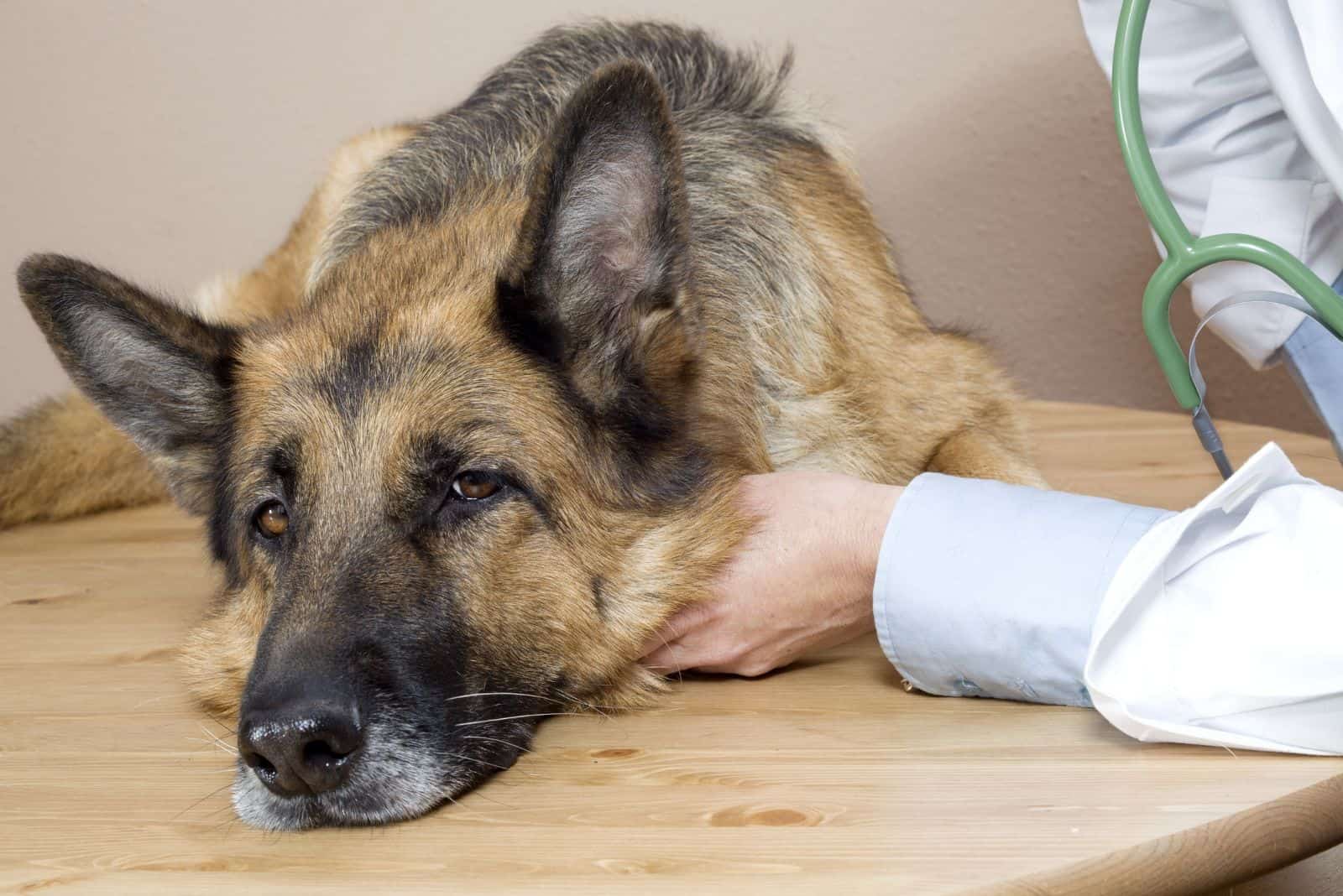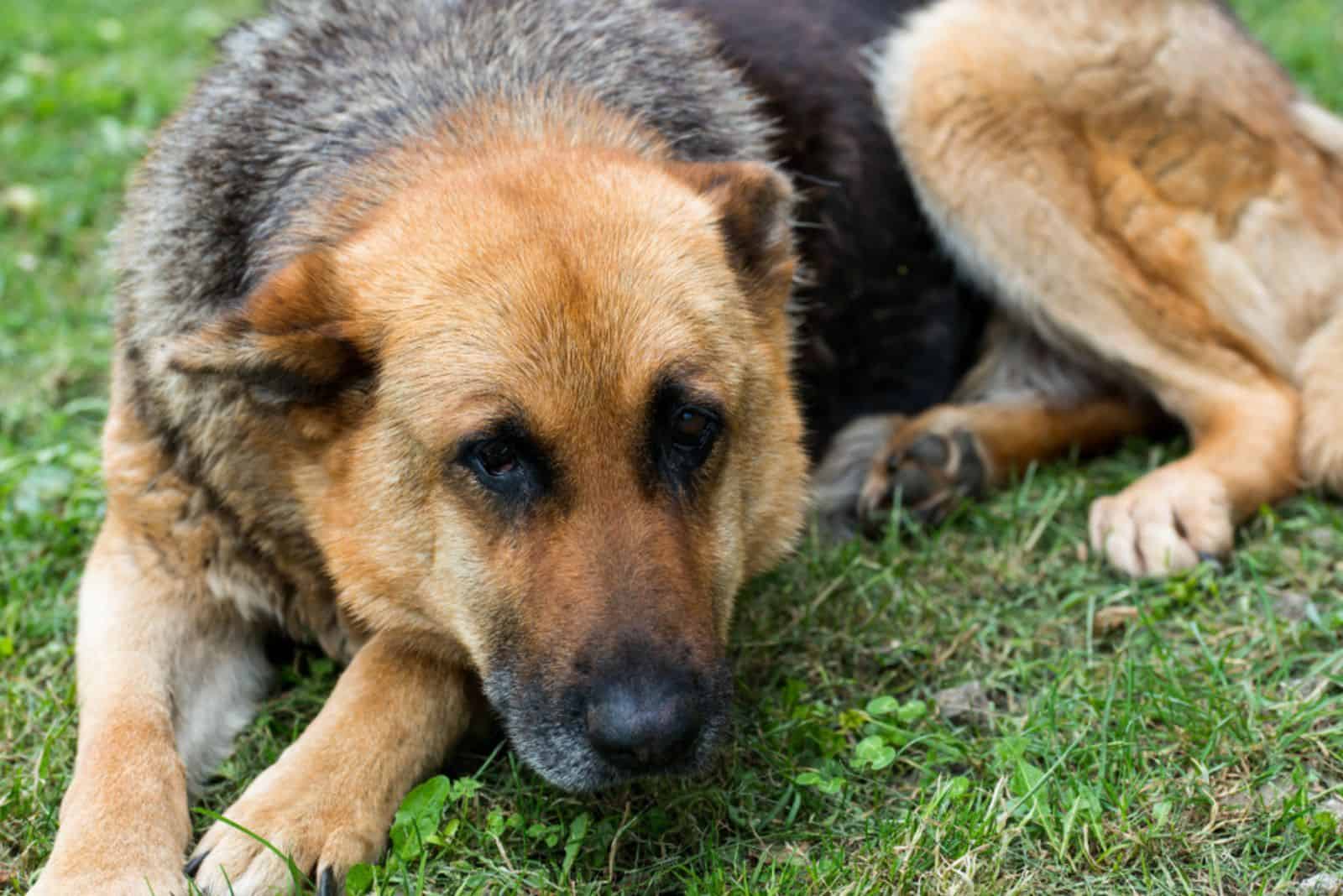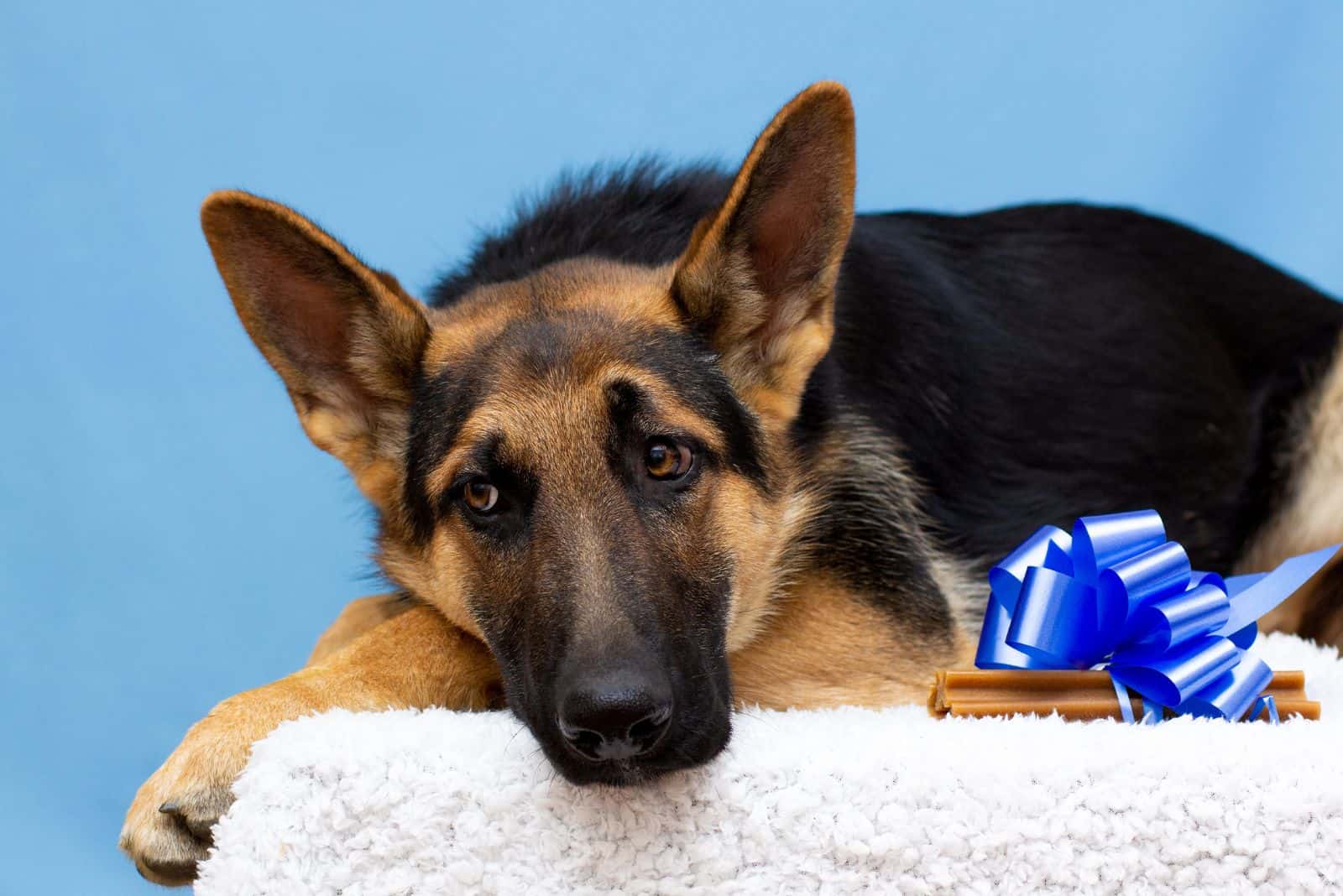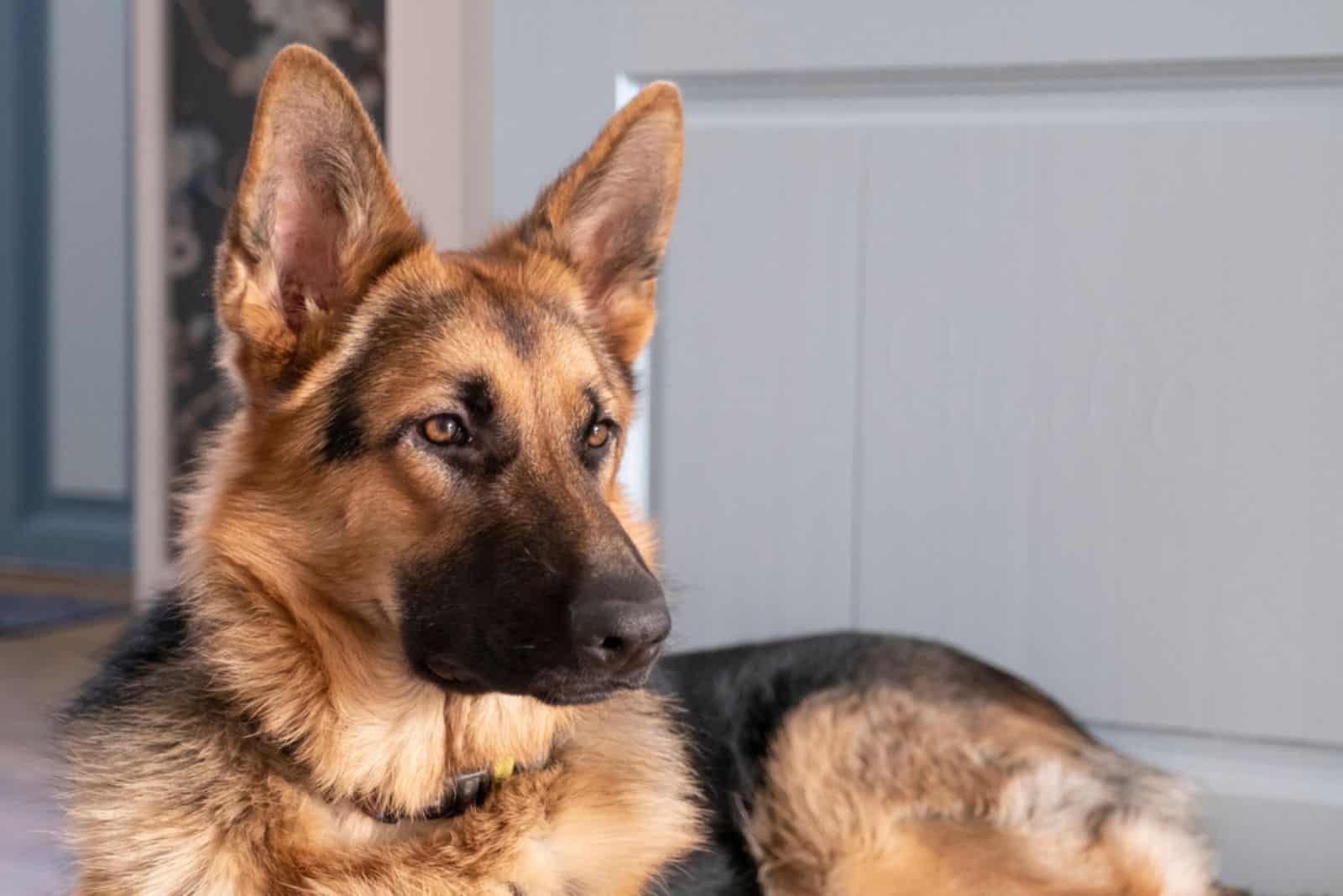Sadly, our dogs can’t live forever and they often get sick despite us giving them the best possible care.
Simply put, there are some things that we cannot predict, account for, or do anything about. When it comes to German Shepherds, in particular, they can often struggle with a number of spinal problems that can cause them a great deal of pain.
Some of these issues can be treated with success, while others get more serious, and in some cases, fatal.
I’ve decided to put together this list of six German Shepherd spinal problems that every GSD owner should know about in order to put themselves in the best possible position to treat them.
1. Degenerative Myelopathy

Let’s start off the list with degenerative myelopathy, also known as DM.
DM, which affects various dog breeds, including the German Shepherd, is a deadly, long-lasting, and degenerative condition of the spinal cord.
It is a sad illness with no known cure and ultimately results in total paralysis of the dog’s limbs.
Degenerative Myelopathy Symptoms
A German Shepherd suffering from degenerative myelopathy will at first experience weakness in the hind limbs and have difficulty standing up straight.
It will partially lose sensation in its hind limbs, which will cause incorrect paw placement, dragging of the paws, and scuffing of the toenails.
As the condition progresses, the affected dog will lose the ability to stand or use its hind limbs to support itself. It could even lead to issues with fecal and urine incontinence.
The disease will eventually spread to the forelimbs and brainstem, leaving the dog completely paralyzed and causing difficulties with breathing, eating, and drinking.
Degenerative Myelopathy Treatment
As I’ve already mentioned, degenerative myelopathy is a fatal, incurable illness, so the treatment largely focuses on alleviating pain and improving the dog’s quality of life as much as possible.
This can include stuff like high-quality at-home nursing care, mobility aids (including carts, slings, and harnesses), and physical therapy.
2. Cauda Equina Syndrome
Next up is the cauda equina syndrome, also known as lumbosacral stenosis and literally translated from Latin as “horse’s tail.” It is a narrowing of the spinal canal around a certain area.
Cauda Equina Syndrome Symptoms
Cauda equina symptoms include difficulties lying down and rising from a sitting position, pain in the back, tail, or rear limbs, an abnormal gait, and occasionally excessive chewing on the hind limbs and pelvic areas as a result of the nerve pain.
A lot of these symptoms frequently look like those of other disorders, such as hip dysplasia, spinal subluxations, or even back or leg muscle strains. That’s what makes this condition so hard to diagnose.
Cauda equina can occasionally be detected on x-rays. Still, more often than not, a special dye must be injected into the afflicted area to improve contrast, or an MRI must be performed.
Cauda Equina Syndrome Treatment
The best course of treatment will typically be determined by the exact cause and severity. Mild cases are managed with anti-inflammatory drugs accompanied by mandatory rest for 6 to 8 weeks.
When it comes to more severe cases, surgery is frequently the only course of action, after which your dog will have to rest even more. Like with any surgery, make sure not to let your GSD lick its wound.
3. Subluxations

Subluxation is a spinal condition that refers to the misalignment of one or more vertebrae.
Subluxation Symptoms
Subluxations can significantly affect German Shepherds in a number of ways, including limiting the range of motion in their joints, pinching spinal nerves, tightening and straining muscles, producing aberrant gait and movement, and more.
Other signs and symptoms include stiffness, restlessness, back pain, and difficulty sitting or standing up.
Ultimately, this results in uneven muscle development and overcompensation which wears out and may even injure the muscles that are now bearing the weight.
Subluxation Treatment
Subluxation of the spine is most frequently treated surgically. However, these operations are highly complex due to the sensitive nature of the dog’s spine.
In some instances, various methods of rehab can be used instead of surgery. For example, a combination of exercise, nutritional supplements, and walking aids.
4. Back Strains
The German Shepherd’s back muscles might occasionally become sore from strenuous physical activities such as running or agility exercises. Part of the reason why GSDs are prone to this is that they have sloped backs.
Back Strains Symptoms
Back strains can cause the muscles to tense up, reduce their flexibility, and limit the range of movement on one side of the dog’s body.
You can notice this if your GSD has a clear preference for one side over the other and is unable to turn or stretch to that side.
Even though your dog might not show it, this condition can be pretty painful. Its muscles could get inflamed which can lead to all sorts of discomfort.
German Shepherds are playful and active dogs, and back strains can make it difficult for them to even lay down, jump, or stretch.
Back Strains Treatment
Since this is an issue brought on entirely by physical stress, and not a genetic predisposition or something like that, the treatment is much more straightforward.
However, that doesn’t mean that you should take it lightly.
If you notice that your German Shepherd is experiencing back pains, make sure to limit its physical activity so as to not aggravate the condition. Stick to simple, short walks that don’t take a toll on your dog’s back.
Perhaps consider getting your GSD a harness that could support its back effectively.
You should also do something to help your pooch deal with the pain. Even though it might be putting on a brave face, it’s definitely feeling a certain level of discomfort. Talk to your regular vet and ask them to recommend some pain medication.
Do not, under any circumstances, buy a pain relief treatment on your own, without first consulting an expert.
5. Spondylosis

In elderly German Shepherds, particularly those that have been quite active throughout their lives, a special form of arthritis, known as spondylosis, can often develop.
Spondylosis Symptoms
In dogs that are suffering from spondylosis, a new bone grows on the underside of the vertebrae, and it may eventually cover the space between two vertebrae.
Spondylosis typically develops as the body attempts to stabilize the spine by fusing the vertebrae together. As a result, this ailment most frequently manifests in the areas of the dog’s spine that are most unstable.
These fused vertebrae can cause significant pain and lessen the spine’s general flexibility.
The dog could even find it painful to lie down for extended periods of time due to inflammation from the growing bone spurs.
Spondylosis Treatment
Thankfully, spondylosis is largely manageable in German Shepherds. It will require some extra care and effort, but it’s far from being a lost cause.
The treatment usually consists of cold laser therapy, chiropractic care, and a combination of analgesic and anti-inflammatory medications.
6. Transitional Vertebrae
The final entry on this list, transitional vertebrae is a term used to describe a congenital deformity of the spine, that is much more prevalent in German Shepherds than in other dog breeds.
This deformity can occur at the intersection of either the lumbar and sacral junction or the thoracic and lumbar junction, but that probably won’t mean much to you unless you’re an expert in canine anatomy.
Transitional Vertebrae Symptoms
Although many dogs with transitional vertebrae don’t show a lot of signs and can, in fact, lead relatively normal lives, this condition might increase the incidence of hip dysplasia, spondylosis, arthritis, and even cauda equina in the spine.
It makes the dog lose stability in the lower part of its spine, which can make it difficult to jump, run, or even walk.
Transitional Vertebrae Treatment
Depending on the exact location of the issue and the severity, there are multiple treatment options for your German Shepherd suffering from transitional vertebrae.
Surgery is a possibility and it can be supplemented with a lengthy post-op rehab process that includes pain medication and limited exercise regimes that are used to slowly build back strength and stability.
These rehab methods can sometimes be applied even without the dog going through surgery.
A decision on whether or not to have your GSD undergo surgery will have to be made, so you have to have a long conversation with your vet.
Final Thoughts
The six German Shepherd spinal problems listed here aren’t the only conditions that can affect GSDs, but they are among the most common and serious ones.
If you learn as much as you possibly can about them and become able to recognize their symptoms in time, then you give yourself the best possible chance to act early and provide your dog with the best care available.
I hope that your beautiful GSD will never be affected by any of these, but as always, it’s better to be safe than sorry.
